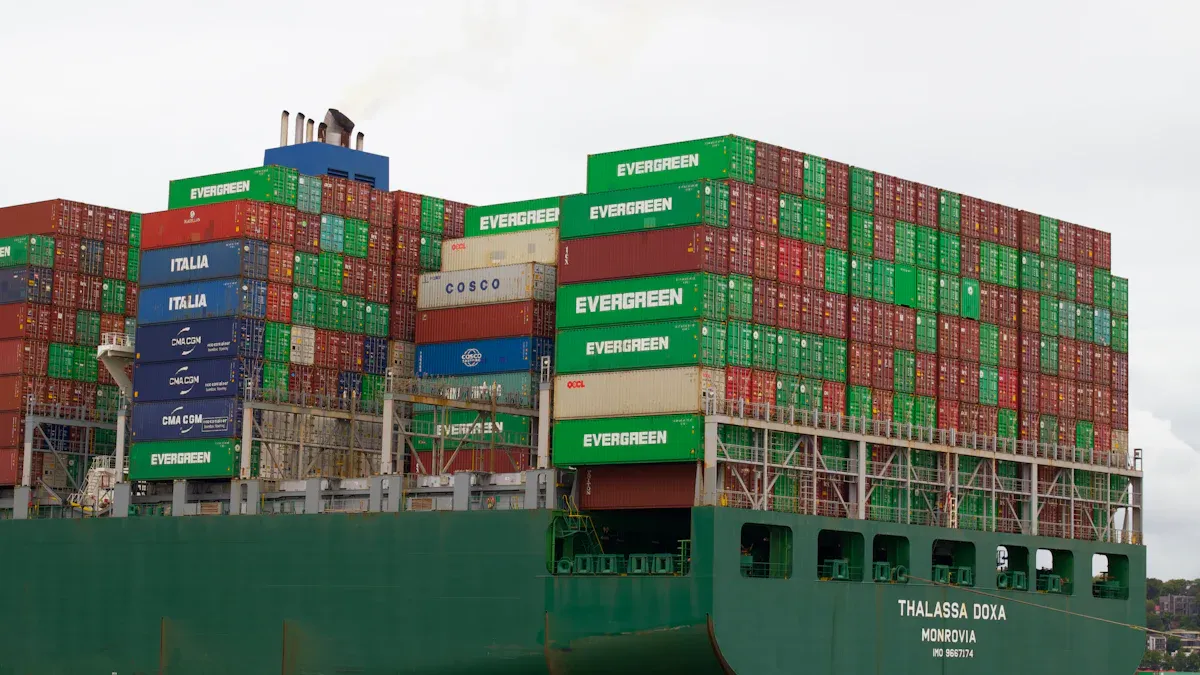Key Practices for Greener Ocean Shipping in 2025

The ocean shipping industry faces critical environmental challenges that demand immediate action. High carbon emissions from traditional methods significantly contribute to climate change. Harmful pollutants like sulfur oxides and nitrogen oxides degrade air quality. Marine pollution, including oil spills and plastic waste, threatens biodiversity. By adopting sustainable practices, you can help protect marine ecosystems and reduce greenhouse gas emissions.
Key Takeaways
Use ship designs that save energy to burn less fuel.
Choose cleaner fuels like LNG, hydrogen, or ammonia to pollute less.
Use smart tools to plan routes better and cut emissions.
Understanding Green Shipping and Its Importance
What Is Green Shipping?
Green shipping refers to practices and technologies that reduce the environmental impact of maritime activities. It focuses on improving energy efficiency, adopting alternative fuels, and complying with international regulations. For example, the International Maritime Organization (IMO) introduced MARPOL Annex VI to limit harmful emissions like sulfur oxides and nitrogen oxides. These measures aim to enhance energy efficiency and reduce greenhouse gas emissions. By embracing green shipping, you contribute to a cleaner and more sustainable future for the maritime industry.
Why Sustainability Matters in Ocean Shipping
Sustainable shipping is essential for protecting the environment and ensuring the long-term viability of the ocean shipping industry. Traditional methods release harmful pollutants, including sulfur oxides and carbon dioxide, which degrade air quality and contribute to climate change. Marine pollution, such as oil spills and plastic waste, disrupts ecosystems and harms marine life. Shifting to sustainable practices reduces these impacts and aligns with growing consumer demand for environmentally responsible choices. Investing in sustainability also improves environmental performance, lowers costs, and ensures compliance with regulations, giving you a competitive edge in the market.
The Role of 2025 Environmental Targets
The 2025 environmental targets set by organizations like the IMO play a crucial role in driving sustainable shipping. These targets align with global sustainability goals, such as those outlined in the Paris Agreement. For instance, the IMO aims to reduce carbon dioxide emissions by 40% by 2030 compared to 2008 levels. These goals encourage you to adopt innovative technologies and practices that enhance efficiency and reduce emissions. Meeting these targets not only demonstrates accountability but also builds trust with stakeholders and ensures the industry's relevance in a rapidly changing world.
Key Sustainable Practices for Greener Ocean Shipping

Energy-Efficient Vessel Design
Energy-efficient vessel design plays a vital role in reducing the environmental impact of ocean shipping. Modern advancements focus on optimizing hull shapes, using lightweight materials, and improving hydrodynamics. These innovations reduce drag and fuel consumption, leading to lower emissions. For example, streamlined hulls and bulbous bows enhance efficiency by minimizing resistance in water. Retrofitting older vessels with energy-saving technologies also improves performance and reduces carbon footprints.
Advancement Type | Description |
|---|---|
Innovations focus on hydrodynamics, optimizing hull shapes, and using advanced materials to reduce weight and drag, leading to lower fuel consumption and emissions. | |
Energy-Efficient HVAC Systems | Modern HVAC systems enhance energy efficiency by optimizing airflow and improving insulation, significantly reducing energy consumption on vessels. |
Tip: Investing in energy-efficient designs not only supports green shipping but also reduces operational costs over time.
Adoption of Alternative Fuels for Sustainable Ocean Freight
Switching to alternative fuels is one of the most impactful sustainable practices in green shipping. The industry has seen a surge in orders for vessels powered by fuels like LNG, hydrogen, and methanol. LNG serves as a transitional fuel, while ammonia and hydrogen offer long-term solutions for zero-emission shipping. These fuels reduce harmful pollutants and align with the IMO’s goal to cut greenhouse gas emissions by 50% by 2050. Ammonia, for instance, is easier to store and has a higher energy density than hydrogen, making it a promising option for future vessels.
Optimized Logistics and Route Planning with JUSDA ESG
Efficient logistics and route planning significantly enhance eco-friendly shipping. JUSDA ESG leverages advanced technologies like IoT and big data to optimize routes, reduce fuel consumption, and minimize emissions. By integrating real-time data, you can avoid congested ports and select the most efficient shipping lanes. This approach not only supports sustainable practices but also improves delivery timelines and reduces costs. JUSDA ESG’s global network and intelligent supply chain solutions make it a valuable partner in achieving green shipping goals.
Waste Management and Pollution Control in Green Shipping
Effective waste management is essential for sustainable ocean shipping. Best eco-practices include waste segregation, recycling, and responsible disposal. Onboard policies and port reception facilities play a critical role in minimizing waste. Innovative technologies like ballast water treatment systems and exhaust gas cleaning systems further reduce pollution. These measures comply with regulations and demonstrate a commitment to environmental stewardship.
Key Practices for Waste Management:
Improve waste separation at port reception facilities.
Implement onboard waste management policies.
Monitor waste weights and enforce accountability through fines.
Note: Proactive waste management not only protects marine ecosystems but also creates opportunities for value generation within the shipping industry.
The Role of Stakeholders in Driving Sustainable Ocean Freight
Responsibilities of Shipping Companies
Shipping companies play a pivotal role in advancing sustainable ocean freight. By adopting eco-friendly technologies and optimizing operations, you can significantly reduce environmental impact. Effective cargo handling techniques, for instance, streamline loading and unloading processes, cutting fuel use and emissions.
Did you know? Streamlined cargo handling can drastically lower fuel consumption, making your operations more efficient and sustainable.
To integrate sustainability into your strategies, consider the following responsibilities:
Optimize energy use by employing energy-efficient vessel designs.
Manage waste effectively to minimize pollution.
Reduce emissions through cleaner fuels and advanced technologies.
Responsibility | Description |
|---|---|
Waste Reduction | Implement practices to minimize waste generated during shipping operations. |
Use technology to plan efficient routes that reduce fuel consumption and emissions. | |
Adopting Eco-Friendly Tech | Integrate technologies that lower environmental impact, such as cleaner fuels and energy-efficient vessels. |
Setting clear performance targets and incentivizing green technologies further embeds sustainability into your operations. By doing so, you not only meet environmental goals but also enhance your market competitiveness.
Government Policies and Regulations for Green Shipping
Government policies provide the framework for green shipping initiatives. These regulations encourage you to adopt sustainable practices and invest in cleaner technologies. For example, Japan’s Green Innovation Fund supports research into low-emission maritime technologies, while California’s Low Carbon Fuel Standard rewards the use of low-carbon fuels.
Country | Policy/Program | Description |
|---|---|---|
Japan | Green Innovation Fund for Shipping | Grants for R&D of low-emission maritime technologies like hydrogen vessels. |
Germany | Subsidy Program for Low-Emission Engines | Supports shipowners upgrading vessels with cleaner engines. |
California | Low Carbon Fuel Standard (LCFS) | Rewards shipowners using low-carbon fuels with tradable carbon credits. |
Denmark | Green Maritime Fund | Funds green retrofits and maritime innovation to reduce emissions. |
These policies not only promote sustainable ocean freight but also provide financial incentives for adopting eco-friendly solutions. Programs like the EU Emissions Trading System and Singapore’s Green Ship Programme further demonstrate how regulations drive innovation and accountability in the shipping industry.
International Collaboration and Standards for Sustainable Practices
Global collaboration is essential for achieving greener ocean shipping. The International Maritime Organization (IMO) facilitates cooperation among governments to establish standards for safety and pollution control. Its 2023 Strategy on the Reduction of Greenhouse-Gas Emissions from Ships aims for net-zero shipping by 2050, emphasizing alternative fuels and technologies.
International standards require cooperation among governments, regulatory bodies, and industry stakeholders. This collaboration ensures the widespread adoption of sustainable practices.
By aligning with international standards, you contribute to a unified effort to decarbonize the shipping industry. Such partnerships foster innovation, streamline regulations, and accelerate the transition to sustainable ocean freight.
Innovative Technologies and Strategies for Green Shipping

AI and Big Data for Route Optimization in Ocean Shipping
AI and big data are transforming ocean shipping by optimizing routes and reducing carbon intensity. These technologies analyze real-time data, such as weather patterns, ocean currents, and vessel traffic, to determine the most fuel-efficient paths. By avoiding congested areas and adjusting speeds, you can minimize fuel consumption and emissions. Predictive maintenance, powered by AI, also prevents breakdowns, ensuring smoother operations and sustainability.
Big data analytics enhances decision-making by processing historical and real-time information. For example, it helps you balance fuel efficiency, time, and safety when planning routes. Tools powered by AI predict delays and congestion, allowing you to adjust operations proactively. This approach not only supports eco-friendly shipping but also reduces operational costs.
Tip: Leveraging AI and big data ensures compliance with international environmental standards while improving efficiency.
Eco-Friendly Cargo Handling Solutions
Eco-friendly cargo handling solutions significantly reduce the environmental impact of shipping operations. Many companies now use biodegradable and recyclable packaging materials. Shore power, or cold ironing, allows vessels to connect to a port’s electrical grid while docked, cutting emissions and noise pollution. Renewable energy sources, such as solar panels and wind turbines, further enhance sustainability.
Eco-Friendly Solution | Description |
|---|---|
Eco-efficient powertrains | Use of batteries or hydrogen fuel cells for energy-efficient cargo handling. |
Lightweight design using high-strength materials | Reduces equipment weight, lowering energy consumption and wear. |
Productivity-adapted energy consumption | Adjusts energy use based on performance requirements. |
These innovations align with sustainable solutions, helping you achieve eco-friendly shipping goals while maintaining operational efficiency.
Carbon Capture and Storage Technologies
Carbon capture and storage (CCS) technologies offer a promising solution for reducing greenhouse gas emissions in ocean shipping. These systems capture carbon dioxide from ship exhaust before it enters the atmosphere. The captured carbon is then stored safely or repurposed for industrial use. By integrating CCS into your operations, you can significantly lower carbon intensity and meet global sustainability targets.
Emerging CCS technologies are becoming more efficient and cost-effective. For instance, onboard systems now capture emissions without compromising vessel performance. This innovation ensures that you can adopt greener practices without sacrificing profitability. As the industry moves toward net-zero emissions, CCS will play a critical role in achieving this goal.
Note: Investing in CCS technologies demonstrates your commitment to sustainable solutions and positions your business as a leader in eco-friendly shipping.
Balancing Sustainability and Profitability in Ocean Shipping
Cost-Effective Green Shipping Strategies
Adopting cost-effective strategies can help you achieve green shipping goals without compromising profitability. Sustainable logistics planning is a key approach. By optimizing transportation routes and consolidating shipments, you can reduce emissions and energy consumption. For instance, maximizing container utilization lowers ocean freight rates and minimizes your carbon footprint. Efficient supply chain management also streamlines operations, saving costs while reducing environmental impact.
Strategy | Description |
|---|---|
Consolidating shipments | Increases container utilization, leading to reduced ocean freight rates and lower carbon emissions. |
Efficient supply chain management | Streamlines operations to achieve cost savings while minimizing environmental impact. |
Tip: Integrating logistics operations with e-commerce shipping APIs can recommend efficient routes and methods, further enhancing shipping efficiency.
Long-Term Benefits of Sustainable Investments
Investing in sustainable shipping methods offers significant long-term benefits. While green technologies may require upfront costs, they lead to operational savings over time. For example, energy-efficient practices like slow steaming and hull cleaning reduce fuel consumption, directly lowering costs. Staying ahead of environmental regulations also prevents fines and ensures compliance with future standards.
Benefit Type | Description |
|---|---|
Fuel Efficiency | Practices like slow steaming and hull cleaning reduce fuel consumption and operational costs. |
Regulatory Compliance | Avoid fines and prepare for future restrictions by adopting sustainable practices early. |
Operational Savings | Energy-efficient technologies provide long-term savings, outweighing initial investments. |
Sustainability also enhances your brand reputation. Customers and investors increasingly prefer businesses committed to environmental responsibility. This shift can help you attract more clients and secure better financing terms.
Incentives and Funding Opportunities for Sustainable Ocean Freight
Governments and organizations offer various incentives to support green shipping initiatives. Programs like the UK Clean Maritime Demonstration Competition provide grants for clean maritime technology projects. Certification schemes, such as the Green Award Program, reward eco-friendly ships with reduced port fees. Similarly, the Environmental Ship Index rates vessels based on emissions, offering fee reductions for low-emission ships.
Program Name | Description | Key Actions |
|---|---|---|
UK Clean Maritime Demonstration Competition (CMDC) | Grants for clean maritime technology projects. | Apply for funding focusing on alternative fuels. |
Green Award Program | Certification scheme rewarding eco-friendly ships. | Achieve certification for reduced port fees. |
Environmental Ship Index (ESI) | Rating system rewarding low emissions. | Enroll vessels for fee reductions. |
Maritime Singapore Green Initiative | Financial benefits for sustainable practices. | Enroll in programs for tax rebates. |
Partnering with IMO-backed programs or collaborating with international maritime organizations can also help you access funding and grants for sustainable shipping projects.

JUSDA Solutions
To provide you with professional solutions and quotations.
Adopting sustainable practices like energy-efficient vessel designs, alternative fuels, and optimized logistics ensures greener ocean shipping. Collaboration among shipping companies, governments, and international organizations drives innovation and accountability. Immediate action is essential to meet 2025 environmental goals.
🌍 Take action today to protect marine ecosystems and secure a sustainable future for the shipping industry.
See Also
Discovering Innovations in Sea Freight Logistics for 2024
A Comprehensive Overview of Eco-Friendly Supply Chain Transportation
Five Key Trends Shaping Future Supply Chain Efficiency
Get Prepared: New Transport Technologies Transforming Supply Chains
Sustainability Insights: Robotics Trends in Supply Chain Management
